Internalizing External Accident Costs in Safety Investment Evaluation Using Cost–Benefit Analysis
Abstract
:1. Introduction
2. Objectives and Cost Categories in Road Safety Impact Assessment
- Safety and personal security: it is crucial to assess the impact of transport on people’s quality of life in terms of their safety and security.
- Accessibility for persons with disabilities: this goal aims to ensure that people with disabilities can access various activities and services, leading to their personal satisfaction and well-being.
- Impact on human health: this goal evaluates the effect of transport on people’s quality of life and health.
- Social inclusion: transport can reduce social inequalities and provide access to work, education, healthcare, and other public services.
- Equal opportunities and fair treatment of customers and staff: administrative authorities and transport operators should treat customers equally and avoid discrimination against their staff.
- Medical expenses: this covers emergency care, transportation to the hospital, first aid, hospital treatment, outpatient procedures, rehabilitation, assistive devices, and other medical costs.
- Loss of output to society: this includes the costs of lost production, non-market activities, and frictional costs such as hiring and training replacement workers.
- Costs related to loss of life and injuries in traffic accidents: this encompasses the loss of quality of life in severe injuries, as well as expenses for the families of the victims.
- Material costs refer to expenses for property damage compensation, vehicle repair and purchase, road repair, and compensation for damaged property.
- Administrative costs: this includes expenses for traffic police activities, fire safety and road accident assistance, insurance claims, and legal and administrative expenses.
- Other costs: this category covers time losses in traffic jams due to accidents, vehicle replacement costs, travel expenses for hospital visits, and costs related to adapting the home for the specific needs of the victims.
3. Evaluating the External Accident Costs in Bulgaria
- (1)
- (2)
- Based on existing research at the European level and the recommendations of the Handbook for the Assessment of External Costs in Transport, with the latest update in 2019 [12], the following assumptions are applied when assessing the external costs of road safety in the country:
- The average value of human life (VHL) in Bulgaria is estimated at EUR 1.55 million (as of 2016);
- the average value of the damage caused by severe injuries—13% of the VHL;
- average value of damages for minor injuries—1% of the VHL;
- average of direct and indirect costs (medical costs, productivity losses, administrative costs, etc.)—10% of the VHL
- (3)
- Based on the methodology explained earlier, the total external costs resulting from severe and slight injuries in road traffic accidents amount to EUR 5.756 billion and EUR 2.049 billion, respectively, from 2012 to 2023. Furthermore, the total external cost caused by loss of life in road traffic accidents during the same period is EUR 12.861 billion, as shown in Figure 5. Therefore, the overall external costs of road traffic accidents during this period amount to EUR 20.666 billion.
- (4)
- Road safety’s economic impact could be further demonstrated by evaluating the external accident costs caused by specific vehicles. The external accident costs for a single vehicle on particular routes (marginal costs) are calculated following the recommendations in the External Cost Assessment Manual (tables 8–12, pages 45–49) and Annex 2: General Guidelines for the Calculation of External Costs [13].
4. Assessing the Costs and Benefits of Road Safety Investments
- The impact assessment methodology is required as a first step to collect the necessary statistical information at the city (local), regional, or national level.
- The second step is to define the main impacts or benefits resulting from the reduction in PTP. Since not all impacts can be captured and quantified, possible impacts are described in advance in the general evaluation methodology [13]. Accordingly, the effects of each project are identified. These are assessed as percentage reductions or increases in various road traffic injuries and relate to indicators defined in the collected statistics. This way, the project’s impact on road safety and the country’s national economy can be assessed. Summarized elements of the expected impacts will be described in the following stages of the approach.
- Using the described sequence and after multiplying the statistical data for the relevant indicators (number of road traffic deaths, number of seriously injured, and number of slightly injured) and the expected percentage impact of the implemented project on them, the impact of the respective infrastructure project on road safety is quantified [15].
- For the cost–benefit analysis, the private or internal costs (project construction and deployment costs; operational costs for maintaining the facilities) and external costs (for road accidents) are identified [16].
- The benefits of project implementation are also identified (reduction in the number of road accidents by type).
- The results obtained from the previous stages are used to prepare a financial forecast for the project’s yearly operating costs and the expected economic benefits and savings from the site’s proceeds.
- The benefit–cost ratio (BCR) is finally calculated by comparing the total benefits identified for a specific period to the estimated total costs for project implementation. This evaluation helps understand the project’s effectiveness and impact on road safety.
5. Impact Assessment and Results of the Cost–Benefit Analysis of Projects to Improve Road Safety in Bulgaria
5.1. Case Study 1: Implementing Measures for Renewing and Installing New Vehicle Restrain Systems (VRS) and Buffers and Terminals on the National Road Network (NRN)
5.2. Case Study 2: Deployment of Twenty New (Additional) Speed Cameras along the NRN
6. Conclusions
Funding
Institutional Review Board Statement
Informed Consent Statement
Data Availability Statement
Conflicts of Interest
References
- Nankunda, C.; Evdorides, H. A Systematic Review of the Application of Road Safety Valuation Methods in Assessing the Economic Impact of Road Traffic Injuries. Futur. Transp. 2023, 3, 1253–1271. [Google Scholar] [CrossRef]
- Steinhauser, R.; Lancsar, E.; Bourke, S.; Munira, L.; Breunig, R.; Gruen, R.; Dobes, L.; Bulfone, L.; Glass, K.; Gordon, C.; et al. The Social Costs of Road Crashes: Report for the Bureau of Infrastructure and Transport Research Economics; The Australian National University: Sydney, Australia, 2022. [Google Scholar]
- Andersson, H. The Value of a Statistical Life. Adv. Transp. Policy Plan. 2020, 6, 75–99. [Google Scholar]
- Elvik, R. The Power Model of the Relationship Between Speed and Road Safety: Update and New Analyses; Institute of Transport Economics: Oslo, Norway, 2009. [Google Scholar]
- Hofbauer, F.; Putz, L.-M. External Costs in Inland Waterway Transport: An Analysis of External Cost Categories and Calculation Methods. Sustainability 2020, 12, 5874. [Google Scholar] [CrossRef]
- Wijnen, W.; Wesemann, P.; de Blaeij, A. Valuation of Road Safety Effects in Cost–Benefit Analysis. Eval. Program Plan. 2009, 32, 326–331. [Google Scholar] [CrossRef] [PubMed]
- Rodríguez-Sanz, Á.; Andrada, L.R. Cost–Benefit Analysis of Investments in Air Traffic Management Infrastructures: A Behavioral Economics Approach. Aerospace 2023, 10, 383. [Google Scholar] [CrossRef]
- Pietrzak, K.; Pietrzak, O.; Montwill, A. A Study on the Effects of Applying Cargo Delivery Systems to Support Energy Transition in Agglomeration Areas—An Example of the Szszecin Agglomeration, Poland. Energies 2023, 16, 7943. [Google Scholar] [CrossRef]
- Schnieder, M. Can Cost Effective Transportation Be Sustainable (Reducing Emmissions and External Costs)? Environments 2023, 10, 11. [Google Scholar] [CrossRef]
- Van Wijngaarden, L.; Schroten, A.; van Huib, E.; Sutter, D.; Andrew, E. Sustainable Transport Infrastructure Charging and Internalisation of Transport Externalities—Executive Summary; Publication Office: Brussels, Belgium, 2019. [Google Scholar]
- Schoeters, A.; Wijnen, W.; Carnis, L.; Weijermars, W.; Elvik, R.; Johannsen, H.; van den Berghe, W.; Filtness, A.; Daniels, S. Costs Related to Serious Injuries, D7.3 of the H2020 Project SafetyCube; Loughborough University: Loughborough, UK, 2020. [Google Scholar]
- Van Essen, H.; Van Wijngaarden, L.; Schroten, A.; Sutter, D.; Bieler, C.; Maffii, S.; Brambilla, M.; Fiorello, D.; Fermi, F.; Riccardo, P.; et al. Handbook on the External Costs of Transport—Version 2019—1.1; Publications Office: Brussels, Belgium, 2020. [Google Scholar]
- ADB and Green Transport. External Costs of Transport in ADB Area: Lessons Learnt, Deliverable 6.1; Institute of Traffic and Transport, ADB and Green Transport: Ljubljana, Slovenia, 2013. [Google Scholar]
- Horlemann, J.; Heidinger, M.; Wenner, F.; Thierstein, A. Introducing a Novel Framework for the Analysis and Assessment of Transport Projects in City Regions. Sustainability 2024, 16, 2349. [Google Scholar] [CrossRef]
- European Commission. Transport Accident Costs: A Comprehensive Methodology for Estimating External Costs of Road Accidents. Report from the Expert Group on Infrastructure Charging; European Commission: Brussels, Belgium, 2021. [Google Scholar]
- Nikolova, C. Deliverable 7.1. Cost-Benefit Analysis Report for the Deployment of ITS in Bulgaria; SEE-ITS Project: Sofia, Bulgaria, 2015. [Google Scholar]
- European Road Safety Observatory. Cost-Benefit Analysis Brussels; European Road Safety Observatory: Brussels, Belgium, 2018. [Google Scholar]
- Miola, A.; Paccagnan, V.; Turvani, M.; Andreoni, V.; Massarutto, A.; Perujo, A. Review of the Measurement of External Costs of Transportation in Theory and Practice; Maritime transport—Report 1; European Union: Publications Office: Ispra, Italy, 2008. [Google Scholar]
- Baranyai, D.; Sipos, T. Black-Spot Analysis in Hungary Based on Kernel Density Estimation. Sustainability 2022, 14, 8335. [Google Scholar] [CrossRef]
- Ministry of Regional Development and Public Works. Draft-Ordinance on the Conditions and Procedure for Using Road Restraint Systems and Their Requirements; Ministry of Regional Development and Public Works: Sofia, Bulgaria, 2022. [Google Scholar]
- Doll, C.; Jansson, J.O. User costs and benefits in Measuring the Marginal Social Costs of Transport. Res. Transp. Econ. 2005, 14, 125–154. [Google Scholar] [CrossRef]
- Sánchez-Cambronero, S.; Álvarez-Bazo, F.; Rivas, A.; Gallego, I. Dynamic Route Flow Estimation in Road Networks Using Data from Automatic Number of Plate Recognition Sensors. Sustainability 2021, 13, 4430. [Google Scholar] [CrossRef]
- Traffic Police. Stationary Automated Technical Means for Speed Control; Ministry of Internal Affairs: Sofia, Bulgaria, 2024. [Google Scholar]
- European Road Safety Observatory. Road Safety Thematic Report—Speed; European Road Safety Observatory: Brussels, Belgium, 2021. [Google Scholar]
- Becker, U.; Becker, T.; Gerlach, J. The True Costs of Automobility: External Costs of Cars—Overview on Existing Estimates in EU-27; Institute of Transport Planning and Road Traffic: Dresden, Germany, 2012. [Google Scholar]
- Shokry, S.; Tanaka, S.; Wahaballa, A. Cost-Benefit Analysis of Unconventional Aerial Intersection Designs: Cairo as a Case Study. Sustainability 2022, 14, 17016. [Google Scholar] [CrossRef]
- Venezia, E. Cost–Benefit Analysis in High-Speed Railway Projects: Appraisal of Methodological Approaches and an Initial Social Equity Evaluation, A Case Study. Sustainability 2023, 15, 11344. [Google Scholar] [CrossRef]
- Gössling, S.; Kees, J.; Litman, T. The lifetime cost of driving a car. Ecol. Econ. 2022, 194, 107335. [Google Scholar] [CrossRef]
- Brooks, L.; Liscow, Z. Infrastructure Costs. Am. Econ. J. Appl. Econ. 2023, 15, 1–30. [Google Scholar] [CrossRef]
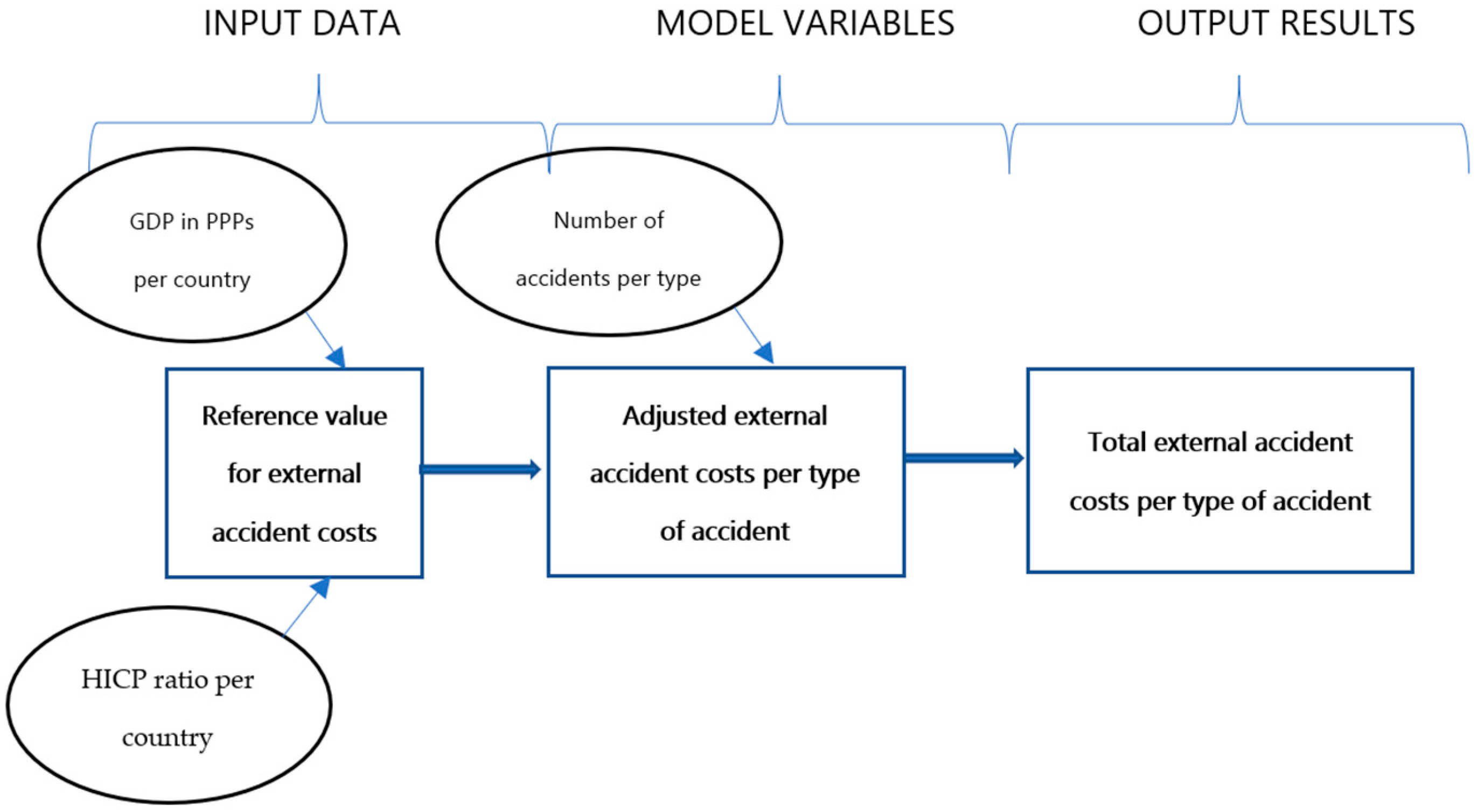
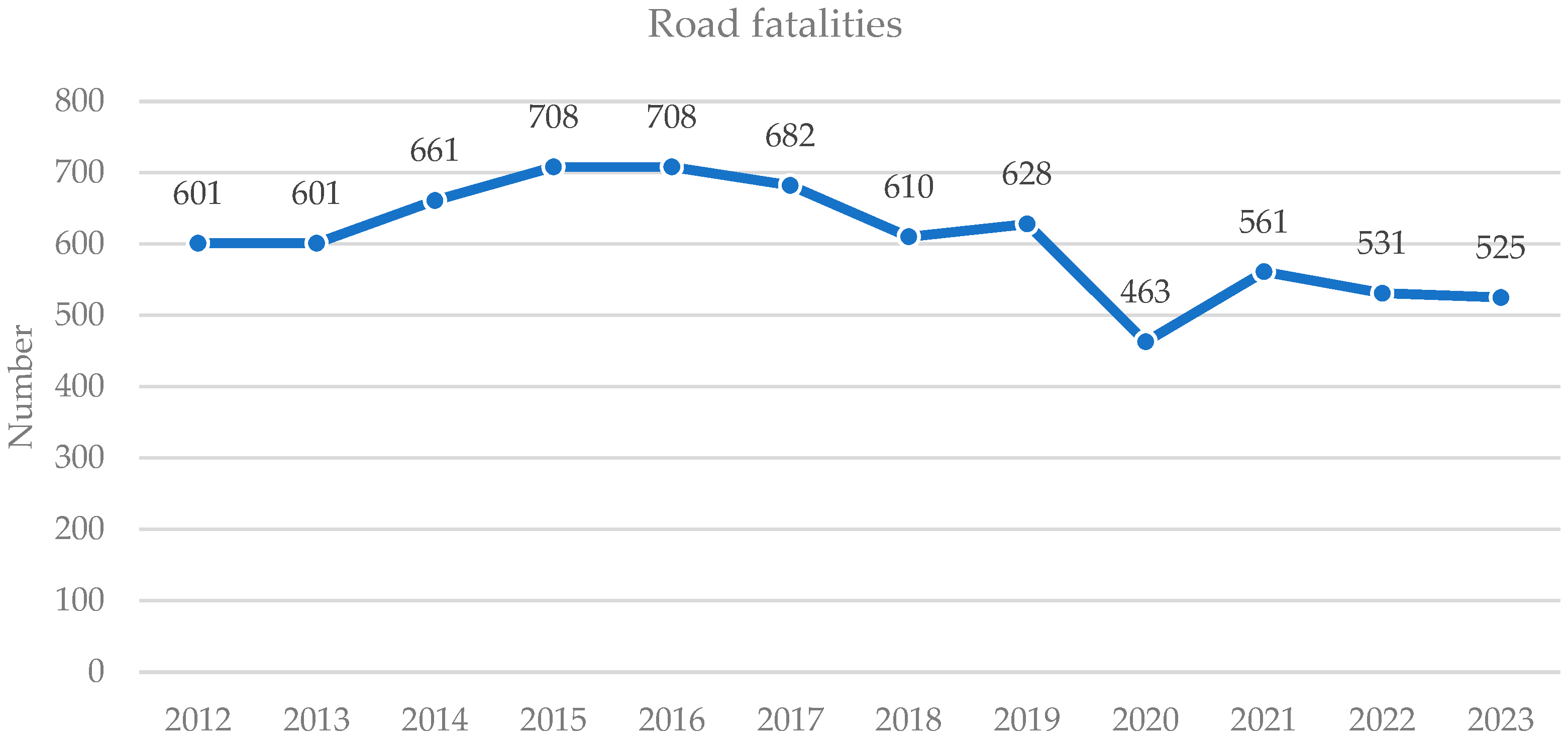
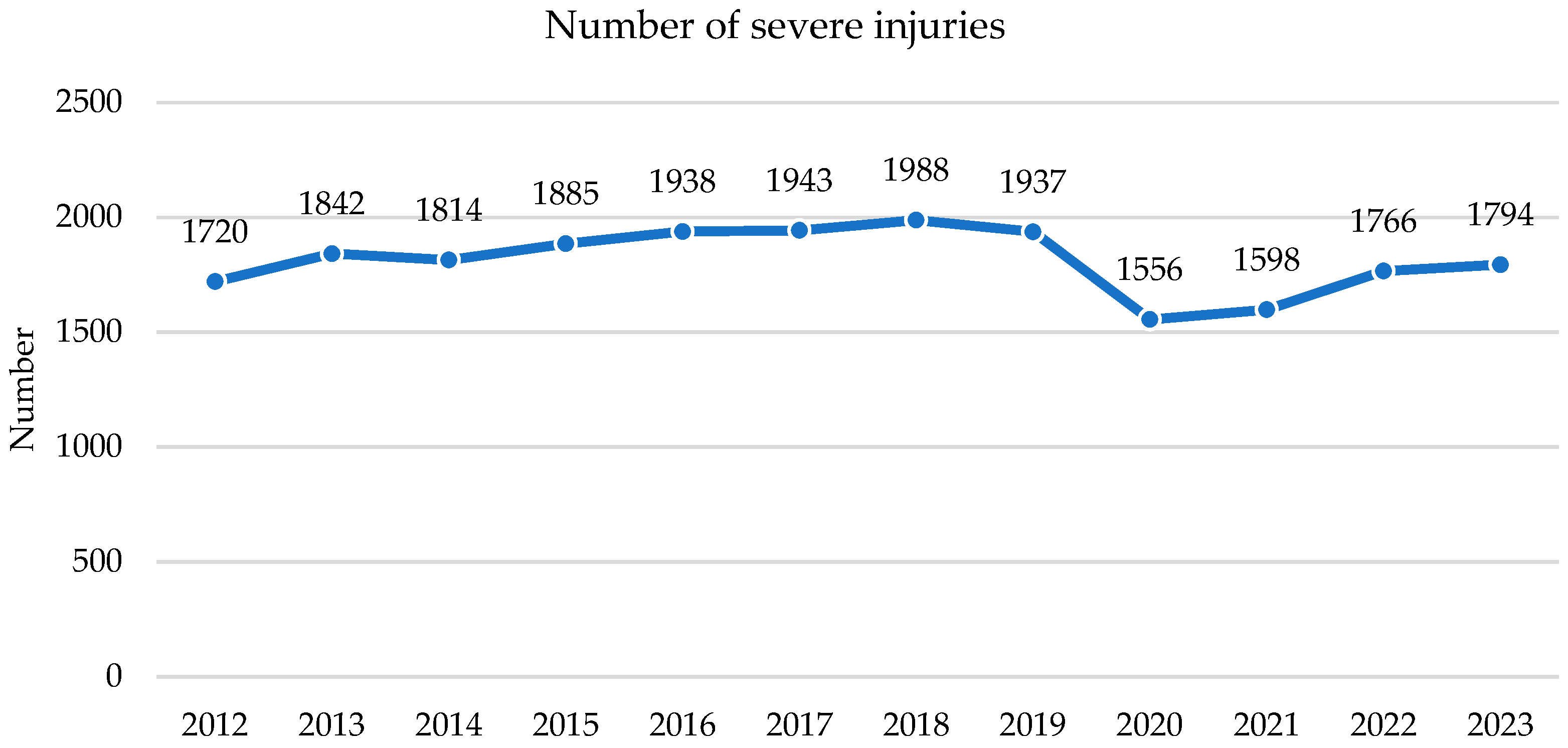
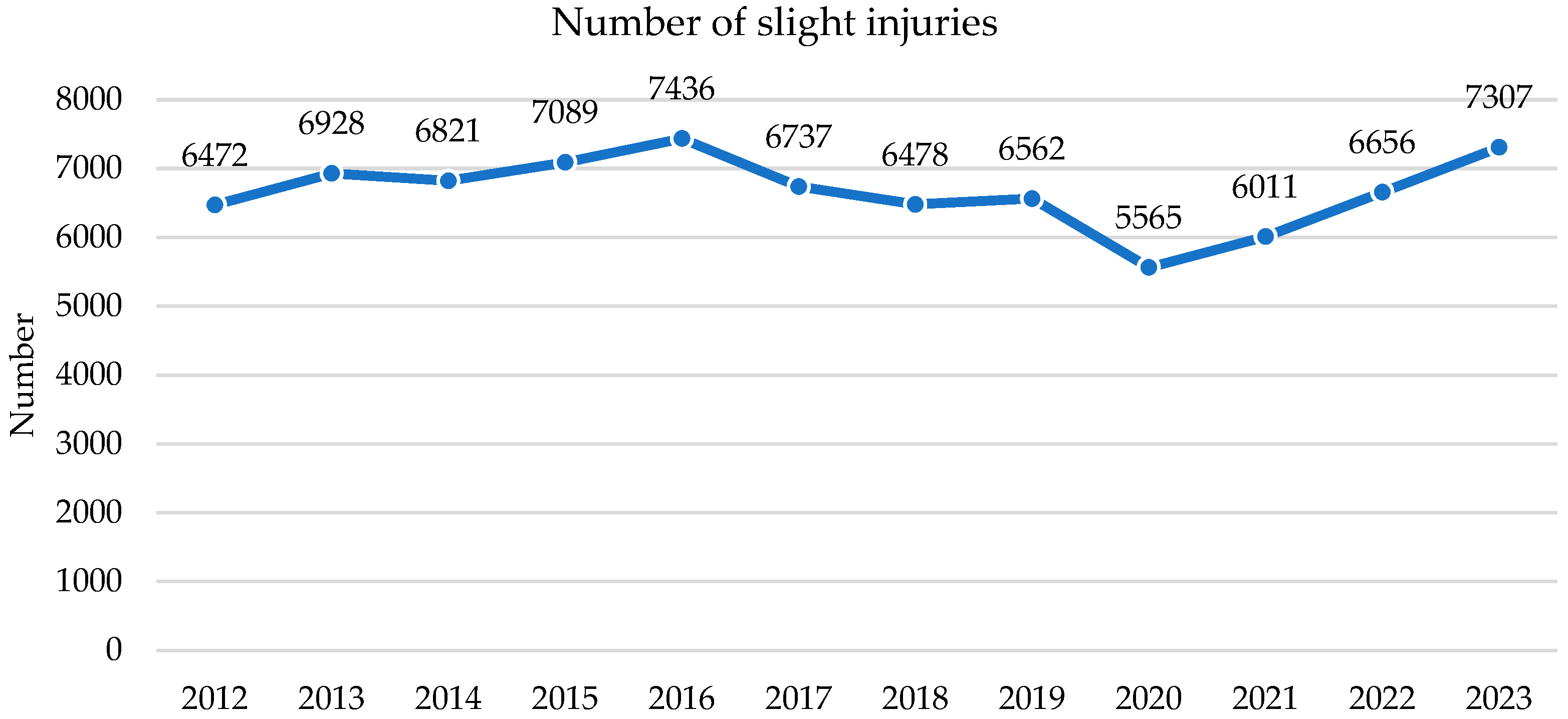

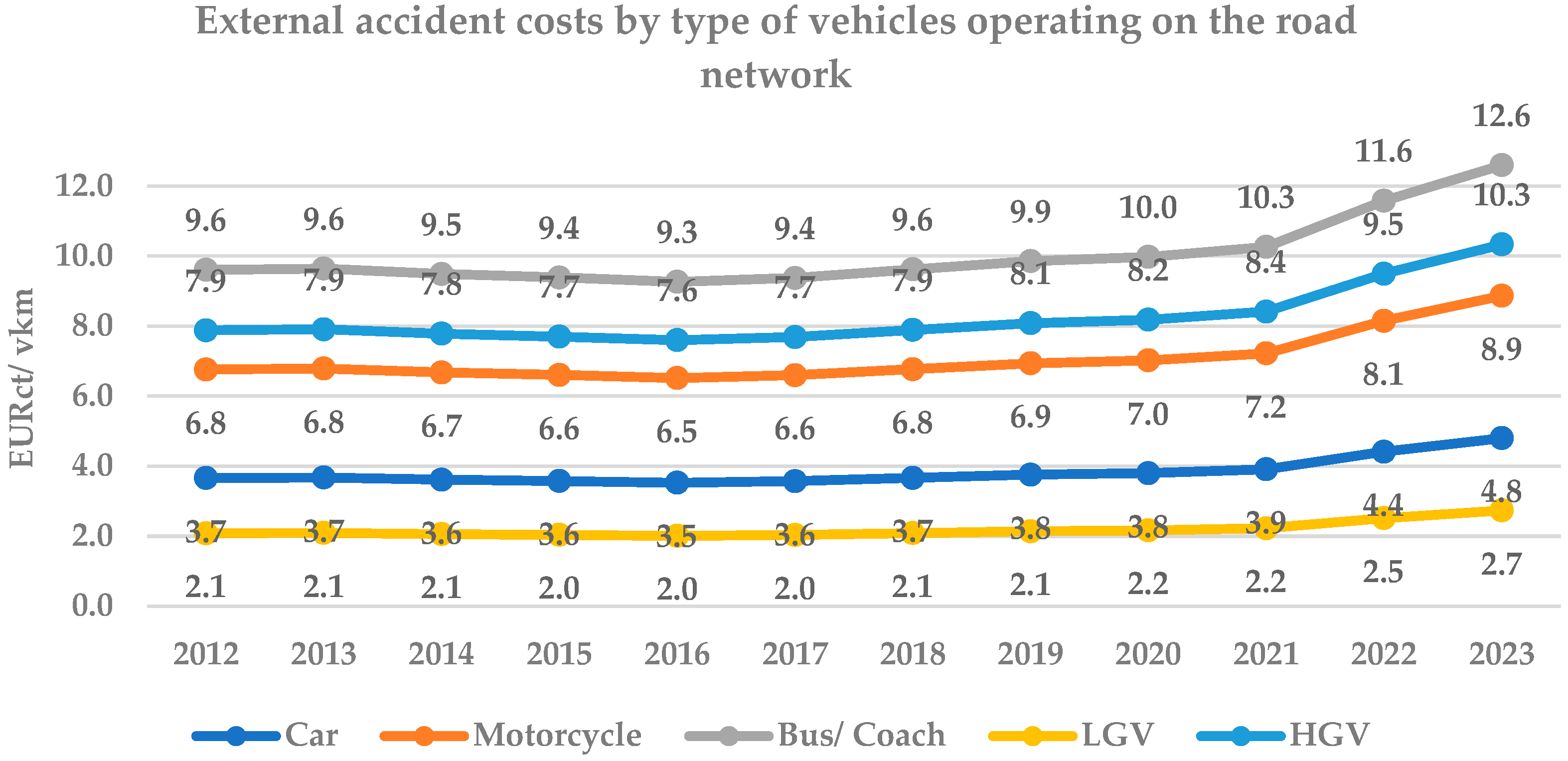
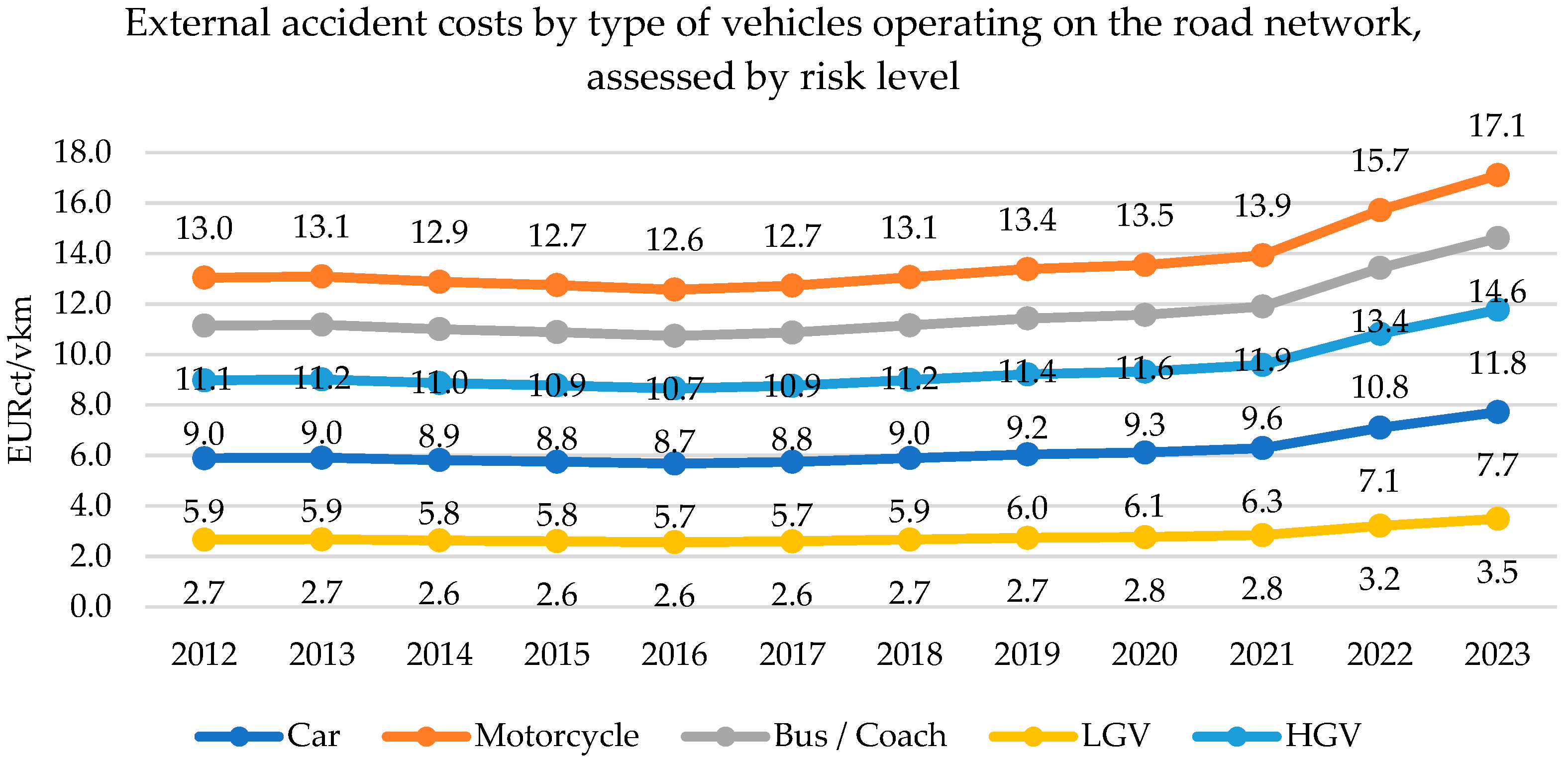
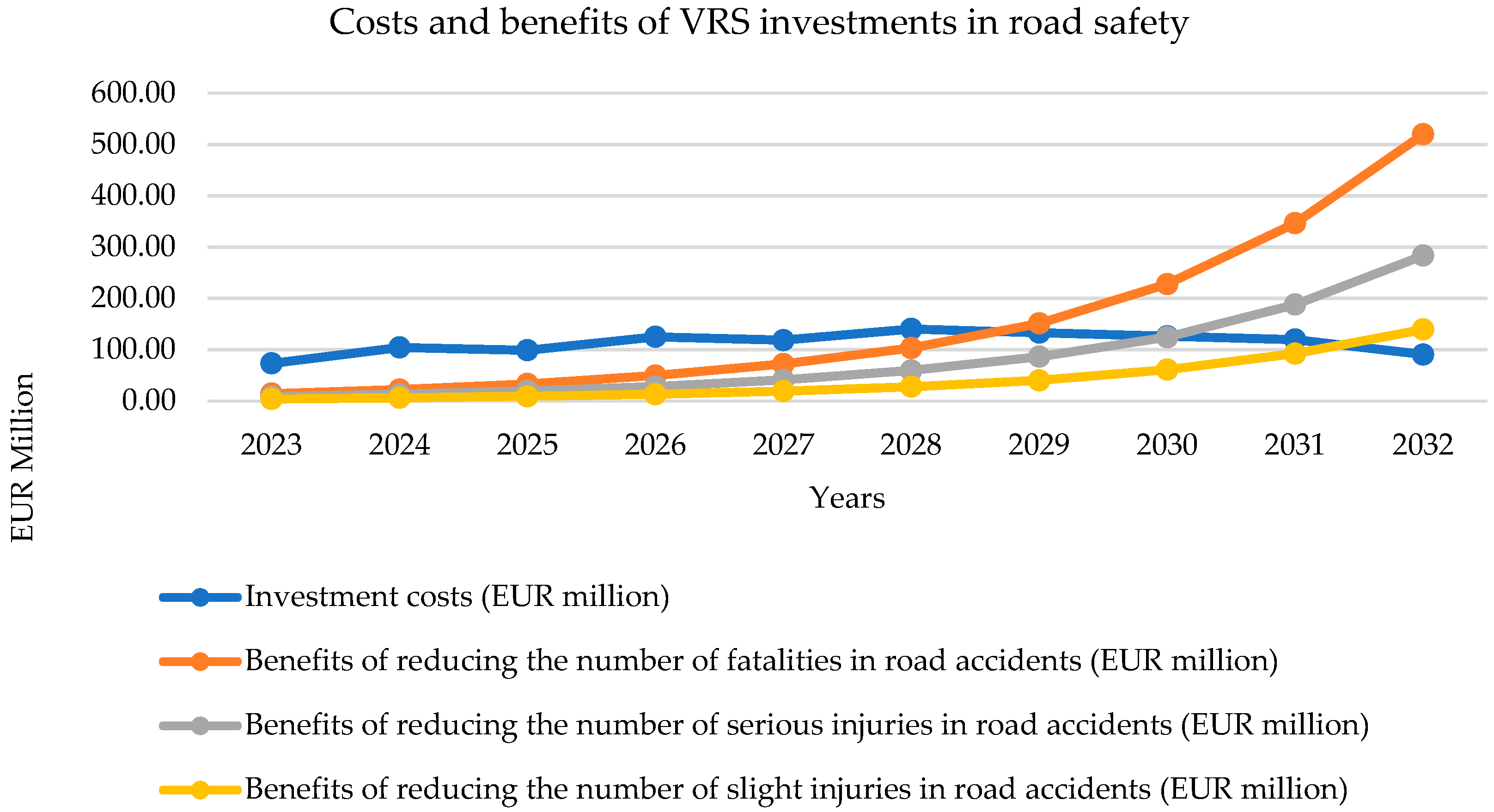
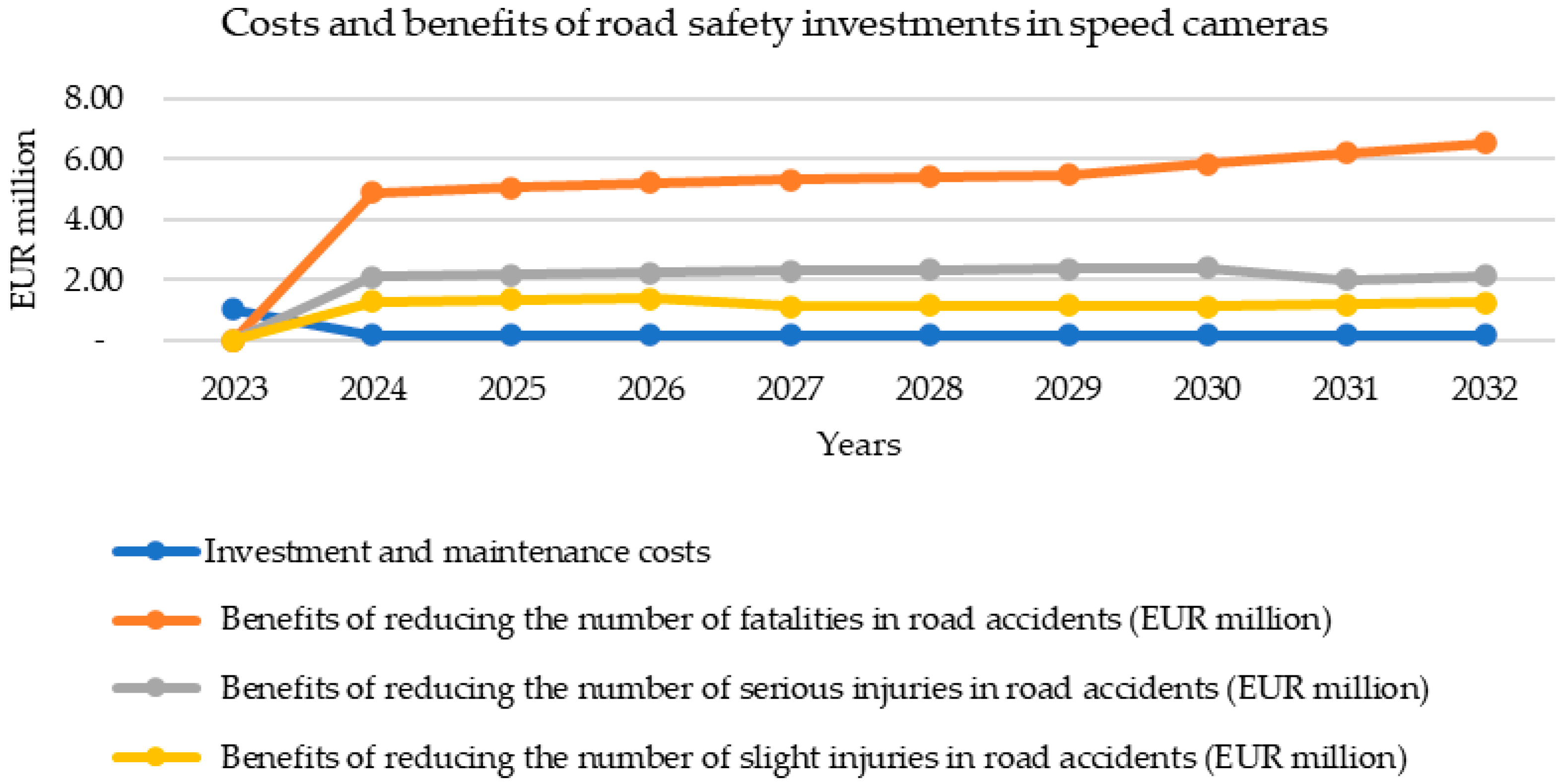
| Types of Traffic Accidents | Cost of Loss of Capacity to Work and Loss of Life, EUR | Loss of Production, Euro | Medical Expenses, EUR | Administrative Costs, EUR | Total External Costs per Person Injured in Traffic Accidents, EUR |
|---|---|---|---|---|---|
| Fatalities | 2,112,551 | 234,219 | 1765 | 1237 | 2,349,772 |
| Severe injuries | 307,292 | 15,591 | 5432 | 851 | 329,166 |
| Slight injuries | 23,638 | 954 | 468 | 366 | 25,426 |
| Adjustment Factors | Values |
|---|---|
| GDP per capita by PPP (2016) | 0.49 |
| HICP 2022 vs. 2016 | 1.36 |
| Class Road | Motorways | Class I | Class II | Class III | Road Junctions | Total |
|---|---|---|---|---|---|---|
| Length of VRS in km required for replacement or new installation | 1028 | 2306 | 3215 | 9469 | 152 | 16,171 |
| Length of VRS in meters required for replacement or new installation | 1,028,381 | 2,306,057 | 3,215,308 | 9,469,325 | 152,141 | 16,171,211 |
| Value in EUR, excluding VAT | 89,386,451 | 200,441,580 | 279,473,349 | 823,070,111 | 13,224,055 | 1,405,595,547 |
| Costs | ||||||||||
|---|---|---|---|---|---|---|---|---|---|---|
| Investment costs | ||||||||||
| Year | 2023 | 2024 | 2025 | 2026 | 2027 | 2028 | 2029 | 2030 | 2031 | 2032 |
| Investment costs (EUR million) | 77.31 | 115.96 | 115.96 | 154.61 | 154.61 | 193.27 | 193.27 | 193.27 | 193.27 | 154.61 |
| Discounted value (EUR million) | 73.28 | 104.19 | 98.76 | 124.81 | 118.30 | 140.17 | 132.86 | 125.94 | 119.37 | 90.52 |
| Benefits | ||||||||||
| Year | 2023 | 2024 | 2025 | 2026 | 2027 | 2028 | 2029 | 2030 | 2031 | 2032 |
| Decrease in the number of fatalities | 6 | 9 | 13 | 19 | 27 | 38 | 55 | 78 | 112 | 159 |
| Cost factor (EUR/fatality) | 2,416,076 | 2,665,507 | 2,914,937 | 3,164,368 | 3,413,799 | 3,663,230 | 3,912,661 | 4,162,091 | 4,411,522 | 4,660,953 |
| Correction factor (Kf) | 1.02 | 1.02 | 1.02 | 1.02 | 1.02 | 1.02 | 1.02 | 1.02 | 1.02 | 1.02 |
| Benefits of reducing the number of fatalities in road accidents (EUR million) | 14.79 | 24.47 | 38.65 | 61.32 | 94.02 | 141.99 | 219.50 | 331.14 | 503.97 | 755.91 |
| Discounted values (EUR million) | 14.01 | 21.99 | 32.92 | 49.50 | 71.93 | 102.97 | 150.89 | 227.64 | 346.45 | 519.64 |
| Reduction in the number of serious injuries | 21 | 31 | 44 | 62 | 89 | 127 | 182 | 260 | 371 | 530 |
| Cost factor (EUR/serious injury) | 340,544 | 375,701 | 410,858 | 446,015 | 481,172 | 516,330 | 551,487 | 586,644 | 621,801 | 656,958 |
| Correction factor (kSI) | 1.25 | 1.25 | 1.25 | 1.25 | 1.25 | 1.25 | 1.25 | 1.25 | 1.25 | 1.25 |
| Benefits of reducing the number of serious injuries in road accidents (EUR million) | 8.94 | 14.56 | 22.60 | 34.57 | 53.53 | 81.97 | 125.46 | 190.66 | 288.36 | 435.23 |
| Discounted values (EUR million) | 8.47 | 13.08 | 19.25 | 27.90 | 40.96 | 59.45 | 86.25 | 124.23 | 187.89 | 283.60 |
| Reduction in the number of slight injuries | 81 | 115 | 164 | 235 | 336 | 479 | 685 | 978 | 1398 | 1997 |
| Cost factor (EUR/ slight injury) | 26,275 | 28,987 | 31,700 | 34,412 | 37,124 | 39,837 | 42,550 | 45,262 | 47,975 | 50,687 |
| Correction factor (kLI) | 2.00 | 2.00 | 2.00 | 2.00 | 2.00 | 2.00 | 2.00 | 2.00 | 2.00 | 2.00 |
| Benefits of reducing the number of slight injuries in road accidents (EUR million) | 4.25 | 6.67 | 10.40 | 16.17 | 24.95 | 38.16 | 58.29 | 88.54 | 134.14 | 202.45 |
| Discounted values (EUR million) | 4.03 | 5.99 | 8.86 | 13.05 | 19.09 | 27.68 | 40.08 | 60.86 | 92.21 | 139.17 |
| Overall benefits of reducing the number of deaths and injuries in road accidents | 26.59 | 40.90 | 60.84 | 90.50 | 131.91 | 190.20 | 277.12 | >412.61 | 626.33 | 942.31 |
| Total costs (EUR million) | 1128.18 | |||||||||
| Total benefits (EUR million) | 2800.04 | |||||||||
| BCR | 2.48 | |||||||||
| Costs | ||||||||||
|---|---|---|---|---|---|---|---|---|---|---|
| Investment costs | ||||||||||
| Year | 2023 | 2024 | 2025 | 2026 | 2027 | 2028 | 2029 | 2030 | 2031 | 2032 |
| Investment costs (EUR million) | 1.02 | - | - | - | - | - | - | - | - | - |
| Maintenance costs (EUR million) | - | 0.19 | 0.20 | 0.21 | 0.22 | 0.23 | 0.24 | 0.25 | 0.27 | 0.28 |
| Discounted value (EUR million) | 1.02 | 0.17 | 0.17 | 0.17 | 0.17 | 0.17 | 0.17 | 0.17 | 0.17 | 0.16 |
| Benefits | ||||||||||
| Year | 2023 | 2024 | 2025 | 2026 | 2027 | 2028 | 2029 | 2030 | 2031 | 2032 |
| Decrease in the number of fatalities | - | 2 | 2 | 2 | 2 | 2 | 2 | 2 | 2 | 2 |
| Cost factor (EUR/fatality) | 2,416,076 | 2,665,507 | 2,914,937 | 3,164,368 | 3,413,799 | 3,663,230 | 3,912,661 | 4,162,091 | 4,411,522 | 4,660,953 |
| Correction factor (Kf) | 1.02 | 1.02 | 1.02 | 1.02 | 1.02 | 1.02 | 1.02 | 1.02 | 1.02 | 1.02 |
| Benefits of reducing the number of fatalities in road accidents (EUR million) | - | 5.44 | 5.95 | 6.46 | 6.96 | 7.48 | 7.98 | 8.49 | 9.00 | 9.51 |
| Discounted values (EUR million) | - | 4.89 | 5.06 | 5.21 | 5.33 | 5.42 | 5.49 | 5.84 | 6.19 | 6.53 |
| Reduction in the number of serious injuries | - | 5.00 | 5.00 | 5.00 | 5.00 | 5.00 | 5.00 | 5.00 | 4.00 | 4.00 |
| Cost factor (EUR/serious injury) | 340,544 | 375,701 | 410,858 | 446,015 | 481,172 | 516,330 | 551,487 | 586,644 | 621,801 | 656,958 |
| Correction factor (KSI) | 1.25 | 1.25 | 1.25 | 1.25 | 1.25 | 1.25 | 1.25 | 1.25 | 1.25 | 1.25 |
| Benefits of reducing the number of serious injuries in road accidents (EUR million) | - | 2.35 | 2.57 | 2.79 | 3.01 | 3.23 | 3.45 | 3.67 | 3.11 | 3.28 |
| Discounted values (EUR million) | - | 2.11 | 2.19 | 2.25 | 2.30 | 2.34 | 2.37 | 2.39 | 2.02 | 2.14 |
| Reduction in the number of slight injuries | - | 25 | 25 | 25 | 20 | 20 | 20 | 18 | 18 | 18 |
| Cost factor (EUR/ slight injury) | 26,275 | 28,987 | 31,700 | 34,412 | 37,125 | 39,837 | 42,550 | 45,262 | 47,975 | 50,687 |
| Correction factor (KLI) | 2.00 | 2.00 | 2.00 | 2.00 | 2.00 | 2.00 | 2.00 | 2.00 | 2.00 | 2.00 |
| Benefits of reducing the number of slight injuries in road accidents (EUR million) | - | 1.45 | 1.59 | 1.72 | 1.48 | 1.60 | 1.70 | 1.63 | 1.73 | 1.83 |
| Discounted values (EUR million) | - | 1.30 | 1.35 | 1.39 | 1.14 | 1.16 | 1.17 | 1.12 | 1.19 | 1.25 |
| Overall benefits of reducing the number of deaths and injuries in road accidents | - | 8.30 | 8.60 | 8.85 | 8.76 | 8.92 | 9.02 | 9.35 | 9.40 | 9.93 |
| Total costs (EUR million) | 2.52 | |||||||||
| Total benefits (EUR million) | 81.13 | |||||||||
| BCR | 32.06 | |||||||||
Disclaimer/Publisher’s Note: The statements, opinions and data contained in all publications are solely those of the individual author(s) and contributor(s) and not of MDPI and/or the editor(s). MDPI and/or the editor(s) disclaim responsibility for any injury to people or property resulting from any ideas, methods, instructions or products referred to in the content. |
© 2024 by the author. Licensee MDPI, Basel, Switzerland. This article is an open access article distributed under the terms and conditions of the Creative Commons Attribution (CC BY) license (https://creativecommons.org/licenses/by/4.0/).
Share and Cite
Nikolova, C. Internalizing External Accident Costs in Safety Investment Evaluation Using Cost–Benefit Analysis. Sustainability 2024, 16, 8717. https://doi.org/10.3390/su16198717
Nikolova C. Internalizing External Accident Costs in Safety Investment Evaluation Using Cost–Benefit Analysis. Sustainability. 2024; 16(19):8717. https://doi.org/10.3390/su16198717
Chicago/Turabian StyleNikolova, Christina. 2024. "Internalizing External Accident Costs in Safety Investment Evaluation Using Cost–Benefit Analysis" Sustainability 16, no. 19: 8717. https://doi.org/10.3390/su16198717








